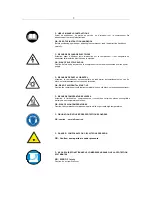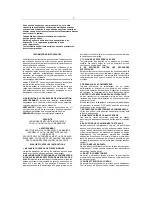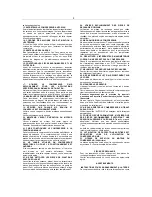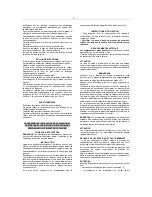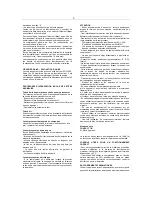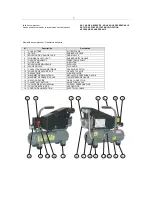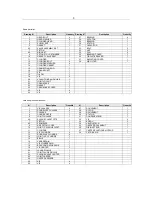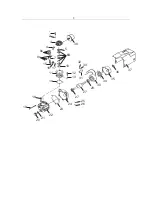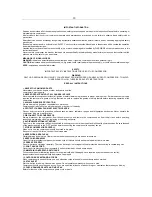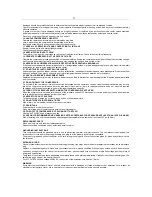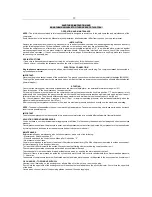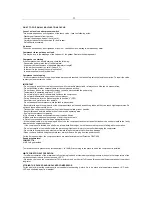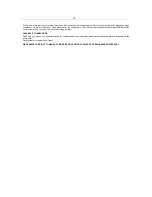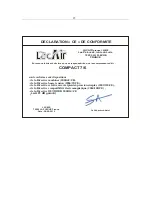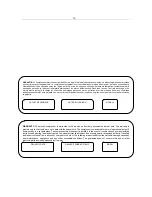
12
SAVE THESE INSTRUCTION AND
MAKE THEM AVAILABLE TO OTHER USERS OF THIS TOOL!
OPERATION AND MAINTENANCE
NOTE:
The information contained in this Instruction Manual is designed to assist you in the safe operation and maintenance of the
compressor.
Some illustrations in this Instruction Manual may show details or attachments that differ from those on your own compressor.
INSTALLATION
Remove the compressor from its packing, makes sure it is in perfect condition, checking if it was damaged during transport, and carry
out the following operations. Fit the wheels and rubber tab on the tanks on which they are not already fitted.
Position the compressor on a flat surface or with a maximum permissible inclination of 10°, in a well aired place, protected against
atmospheric agents and not in a place subject to explosion hazard. If the surface is inclined and smooth, check if the compressor
moves while in operation – if it does, secure the wheels with two wedges. If the surface is a bracket or a shelf top, make sure it cannot
fall, securing it in a suitable way.
USE INSTRUCTIONS
– Take care to transport the compressor correctly, do not overturn it or lift it with hooks or ropes,
– Check oil level, consulting the reference marks on the stick or the oil level inspection window.
ELECTRICAL CONNECTION
Single-phase compressors
are supplied with an electrical cable and a two-pole + earth plug. The compressor
must
be connected to
a grounded power socket.
IMPORTANT:
Never use the ground socket instead of the neutral wire. The ground connection must be made to meet safety standards (EN 60204).
The plug of the power cable must not be used as a switch, but must be fitted in a power socket controlled by a suitable differential switch
(thermal breaker).
STARTING
Check that the mains power matches that indicated on the electrical data-plate – the permissible tolerance range is +/-5%.
Press into position “0” the knob located on the upper section.
Fit the plug in the power socket and start the compressor, turning the pressure switch knob into position “I”. The compressor is fully
automatic, and is controlled by the pressure switch which stops it when tank pressure reaches maximum value and restarts it when it
falls to minimum value. The pressure difference between maximum and minimum values is usually about 2 bar (29 psi).
E.g.: the compressor stops when it reaches 8 bar (116 psi – maximum operating pressure) and restarts automatically when the
pressure inside the tank drops to 6 bar (87 psi).
After connecting the compressor to the power line, load it to maximum pressure and check exactly how the machine is operating.
NOTE:
The head/cylinder/delivery tube unit can reach high temperatures. Take care when working near these parts, and do not touch
them to avoid possible burns.
IMPORTANT
The electro-compressors must be connected to a power socket protected by a suitable differential switch (thermal-breaker).
ADJUSTING OPERATING PRESSURE
You do not have to use the maximum operating pressure at all times. On the contrary, the pneumatic tool being used often requires less
pressure.
On compressors supplied with a pressure reducer, operating pressure must be correctly adjusted. Adjust pressure to the required value
by turning the knob clockwise to increase pressure and anti-clockwise to reduce it.
MAINTENANCE
Before attempting any maintenance jobs on the compressor, make sure of the following:
– Master power switch in position “0”.
– Pressure switch and the control unit switches all off, in position “0”.
– No pressure in the air tank.
You are recommended to replace or clean the air filter element at least every 50h if the compressor operates in a clean environment,
but more frequently if in a dusty environment.
To clean this air filter: dismantle the suction filter and clean the filtering element by blowing compressed air on it.
The compressor generates condensate water which accumulates in the tank.
The condensate in the tank must be drained at least once a week, by opening the drain tap under the tank.
Take care if there is compressed air inside the cylinder, and water could flow out with considerable force. Recommended pressure:
1 – 2 bar max.
Condensate of compressors that are oil lubricated must not be drained into the sewer or dispersed in the environment as it contains oil.
OIL CHANGES – TOPPING UP WITH OIL
Unscrew the oil drain plug on the housing cover, allow all the oil to flow out, and re-screw the plug.
Pour oil into the upper hole of the housing cover until it reaches the level indicated on the stick or indicator. Pour oil into the upper hole
of the head.
Once a week: check oil level of the pumping element and see if it needs topping up.


